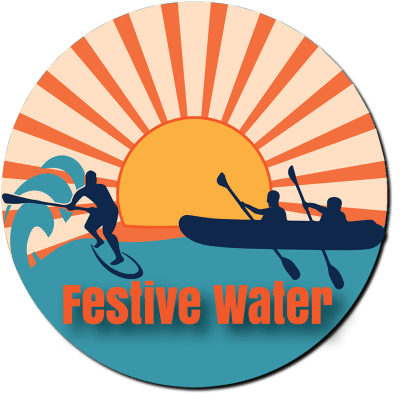Pick a style, find the right fit, always wear it while on the water
Before we get started, I'd just like to say this. Everyone here at Festive Water encourages ALL kayakers and paddle boarders, no mater how swift or calm, flat or choppy, or ideal the water conditions, to ALWAYS wear your PFD while on the water. You never know what could happen. Life jackets save lives.
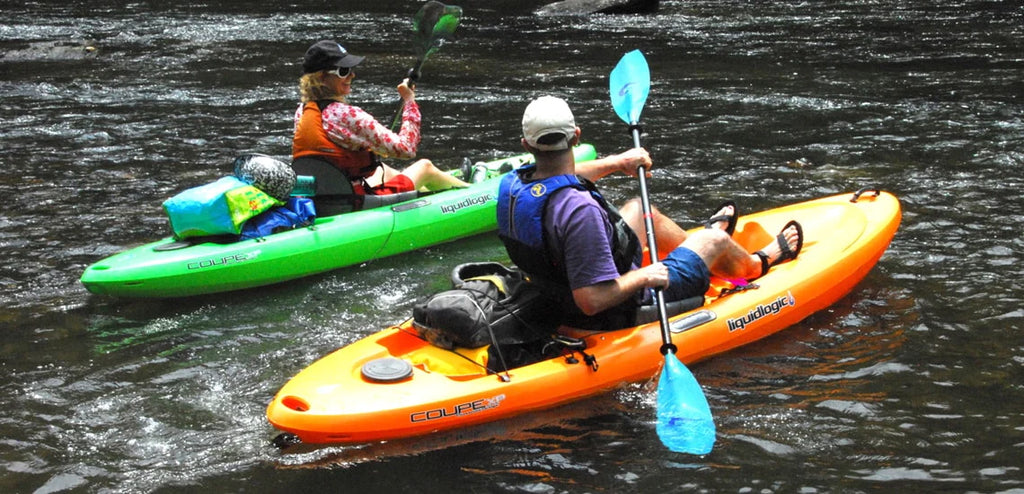
The PFD, or life jacket, is your single most important piece of safety equipment. You need to choose one that fits well and you should wear it whenever you're on the water. This means wearing it securely and not just throwing it over your shoulders, because it can actually impede your ability to swim if it's not worn correctly.
It should fit like a good pair of shoes, snug but comfortable. A good fit test that you can do before hitting the water is to tighten up the life jacket as you would wear it, then hook your thumbs under the shoulder straps and haul upward. The jacket should stay in place around your body and not ride up around your ears.
Any life jacket that's Coast Guard approved, fits well, and is comfortable enough so you don't feel the need to take it off when you're on the water, is a perfectly good life jacket. But the best life jackets for kayaking are those that are made specifically for paddling.
Kayaking specific PFDs have large armholes and keep the bulk of the flotation away from the shoulders and upper chest to give you the fullest range of arm and upper body motion while paddling. Many of them will also have convenient features like zipper pockets for carrying such things as sunscreen, glasses and snacks. And some models even have pouches for hydration bladders that can be mounted on the back of the PFD.
As you read through this article, remember that PFDs only work if you wear them. It’s important to purchase a PFD that is comfortable enough that you’ll be happy to wear it all day long. Focus on fit and comfort and be sure to wear your PFD when you’re on the water.
USCG classification
Most kayakers will choose either a US Coast Guard Approved Type III or Type V life jacket. Most kayaking jackets are Type IIIs. Type Vs will include rescue jackets and pullover jackets.
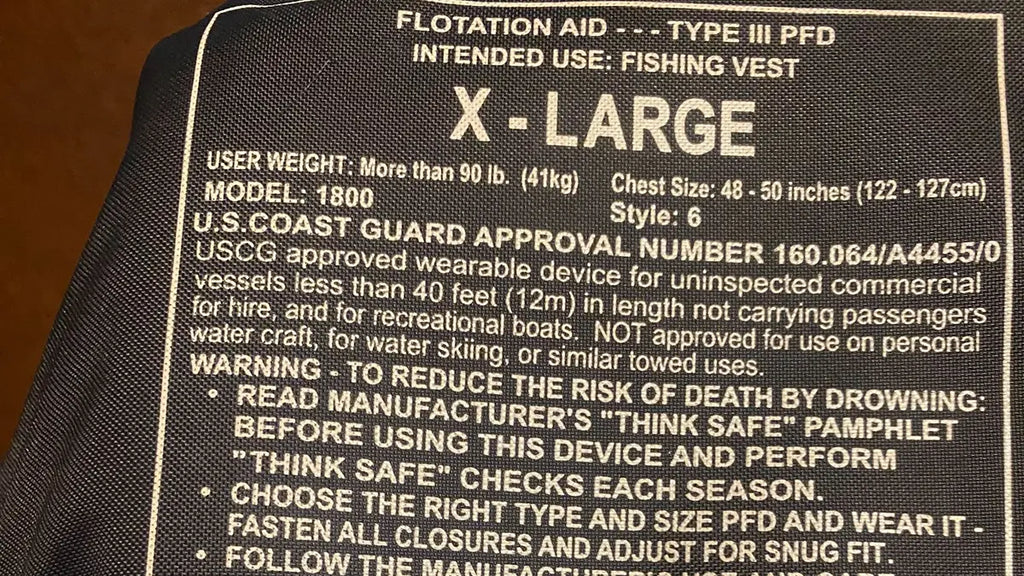
Type III PFDs are buoyancy aids for active sports like kayaking, canoeing, SUP and sailing. They come in a vast array of designs and are far more comfortable for paddling than the bulkier Type I and Type II vests. This is the type of PFD that most paddlers will choose.
Type V PFDs are specialized floatation devices. They may be pullover style vests with no zipper opening, whitewater rescue vests or some types of inflatables. Type V PFDs are only approved for the use for which they are certified and must be worn at all times to qualify toward minimum Coast Guard requirements.
PFD types
Now that we’ve gone over the official PFD categories, we can focus in on the particulars of the types of life jackets that paddlers use: Type III and Type V PFDs. If you start looking at these floatation vests at your local paddling store, you’ll notice they fall into a variety of different categories. There are foam-filled vests and inflatables, mesh-back vests and foam-back vests, and zipper or buckle closures on the front or side. Here’s a breakdown of the pros and cons of each of these different approaches to PFD design.
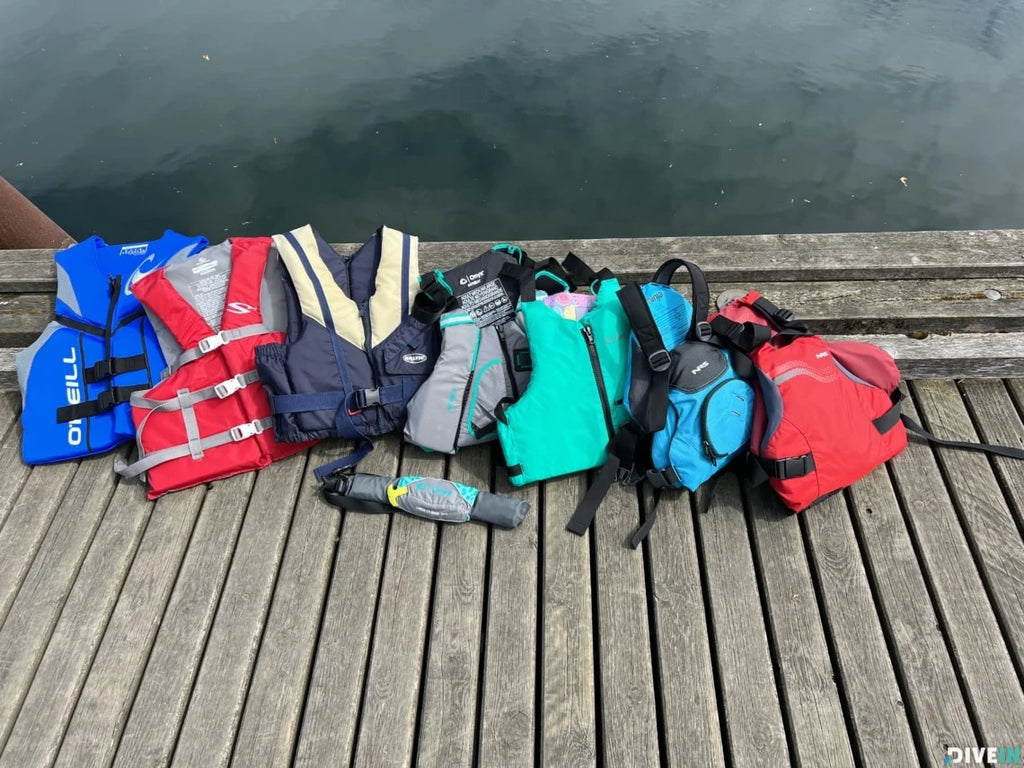
Standard
Foam-filled PFDs provide buoyancy at all times. Those designed for paddling are comfortable to wear on the water and won’t rub you the wrong way. In cold climates, paddlers appreciate the extra insulation and warmth that a conventional PFD can provide.
Most people choose conventional, foam-filled PFDs for paddling, but inflatables win out in certain situations. If you’re paddling in hot conditions or are looking for the most minimal option available, consider an inflatable PFD. If you’re looking for the most versatile choice in a life jacket, stick with a conventional design.
Inflatable
Inflatables are minimalist PFDs that only provide buoyancy when you need it. Uninflated, they are a low-profile horse-collar design or simple waist pack. Inflated, these PFDs typically resemble the Type II PFDs mentioned above.
The advantages of inflatables have mostly to do with their minimal bulk and coverage. In hot weather, an inflatable PFD will be much more comfortable than a conventional vest. Inflatables also have little bulk to get in the way of effective paddling.
Inflatables are comfortable, but they do have some disadvantages. Inflatable PFDs rely on a CO2 cartridge to fill them when needed. This cartridge should be replaced annually, and the inflation mechanism must be kept clean and corrosion free. Once inflated, inflatables place most of the buoyancy at the wearer’s chest, which can make it challenging to swim effectively in some situations. Finally, inflatable vests must be inflated to work. This means having an alert paddler who can activate the inflation mechanism or blow air into the PFD to manually inflate it.
PFD Design & Fit
Foam Placement
All Type III PFDs are required to have 15.5 pounds of buoyancy. In that way, they’re all the same. However, where the buoyancy is placed and how it is sculpted makes a big difference in how a PFD fits. One of the biggest differences you find in foam distribution has to do with how the back of the PFD is designed. There are three main styles: mesh-back, thin-back and standard-back.
Mesh-Back
Mesh-back vests are intended to be used with kayaks that have a tall backrest. In some cases, a standard foam-back PFD may bump against the top edge of a tall backrest and create some discomfort for the paddler. Mesh-back PFDs eliminate this problem by moving the foam on the back of the vest to the top of the back panel. The lower part of the panel is mesh. This design not only prevents interference with tall backrests, it also improves ventilation and comfort in hot weather.
Thin-Back
Thin-back vests are another take on comfort and tall kayak backrests. Thin-back vests have, as you might imagine, thinner foam on the back panel. This means more foam needs to be placed at the front of the vest, so it may be a little bulkier than a mesh- or standard-back PFD. That being said, the thin-back design is very comfortable for many paddlers and works well with taller backrests. Depending on the paddler’s height and the height of the seat, a thin-back PFD may be more comfortable than a mesh-back design.
Standard-Back
Standard-back PFDs have thicker foam on the back panel. This means foam is more evenly distributed between the back and front of the vest. The resulting PFD can feel less bulky than vests with mesh backs or thin backs. Canoeists, sea kayakers and others who don’t need a thin- or mesh-back PFD often find standard-back designs to be comfortable and effective.
PFD Closure
Closure style refers to the general shape of the foam panels that make up a PFD and how the paddler gets into and out of the vest. For instance, a pullover-style PFD has a single large front panel, while a front-zip PFD has two panels separated by a zipper. The three basic closure styles are front-zip, pullover and side-entry.
Front-Zip
Front-zip PFDs are easy to get into and out of. They have a zipper down the middle of the front panel that allows the vest to be opened and put on like a conventional jacket. The front zipper does tend to add a little bit of bulk to these PFDs. It also limits the size of pockets that can be placed on the front of the vest. That being said, front-zip vests are favored by a majority of paddlers who enjoy the convenience of easy on and off entry.
Pullover
Pullover PFDs are minimalist designs that lack a zipper or buckle closure. They are often among the most low-profile PFD designs and are a favorite for whitewater freestyle, SUP or other activities where freedom of motion is at a premium. Because pullovers are difficult to put on while swimming, they are rated as Type V PFDs and must be worn at all times to comply with Coast Guard regulations.
Side-Entry
Side-entry vests combine the fit and comfort of pullover designs with the ability to easily get into and out of the PFD. A side-zip PFD opens on one side under the armpit. To put one on, you pass one arm through the arm hole opposite the side opening and put your head through the collar area. These vests are a little trickier to put on than front-zip PFDs, but many people find them to be very comfortable.
How to properly wear a life jacket
It’s a good idea to get into the habit of correctly adjusting your PFD every time you wear it. The best way to get a secure and comfortable fit is to start with the straps of the PFD loose. When securing your PFD follow these steps:
1. Zip It
Secure the closure on the vest. If it has a zipper, zip it up. If there are only buckles, secure these.
2. Click It
Secure any remaining buckles. There is usually a buckle at the bottom of the PFD near the waist.
3. Tighten The Straps
Start with the lower straps and work your way up, doing both sides at the same time. Finish by tightening the shoulder straps, if they are adjustable.
4. Check It
Check for secure fit by tugging gently upward on the shoulder straps. The PFD should remain in place and not slip upward on the torso.
The trick is to make sure your PFD is securely fitted without being so tight as to be restrictive. Remember, a PFD will only float you if you have it on. It’s important to select a PFD that is comfortable to wear so you’ll have it on should you go for an unexpected swim. Find a PFD that fits and wear it when you’re on the water.
PFD Recommendations
Whitewater
Whitewater PFDs are often low-profile side-entry designs that put a premium on freedom of movement. Specialty whitewater rescue PFDs feature an integrated tow belt that can be used by well-trained kayakers for swiftwater rescue. These swiftwater rescue vests are typically Type V PFDs that must be worn at all times to comply with US Coast Guard regulations.
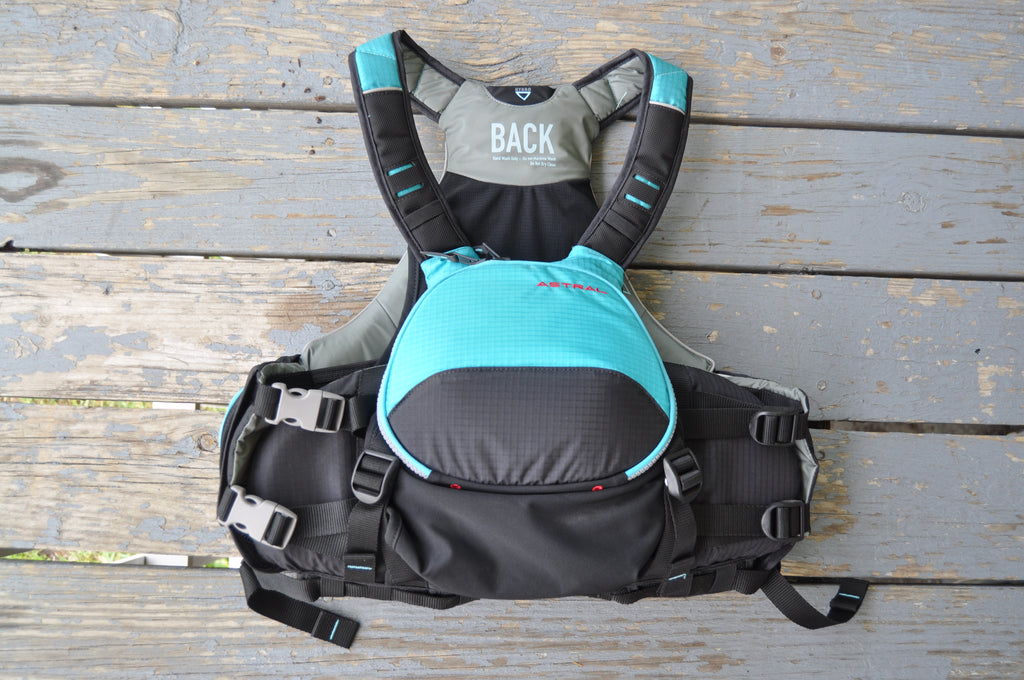
Astral BlueJacket PFD
This life jacket combines incredible fit, lightweight construction, ample organized storage space, and a buffet of technical features. Its versatility allows this jacket to perform on river, lake or sea.
Check out the Astral BlueJacket on the Festive Water Store.
Fishing
Fishing PFDs have lots of pockets. They also have attachment points for lanyards, specialty holsters for pliers, and rod holders for hands-free knot tying. Many fishing PFDs feature mesh- or thin-back designs that are compatible with the tall backrests found on fishing kayaks.
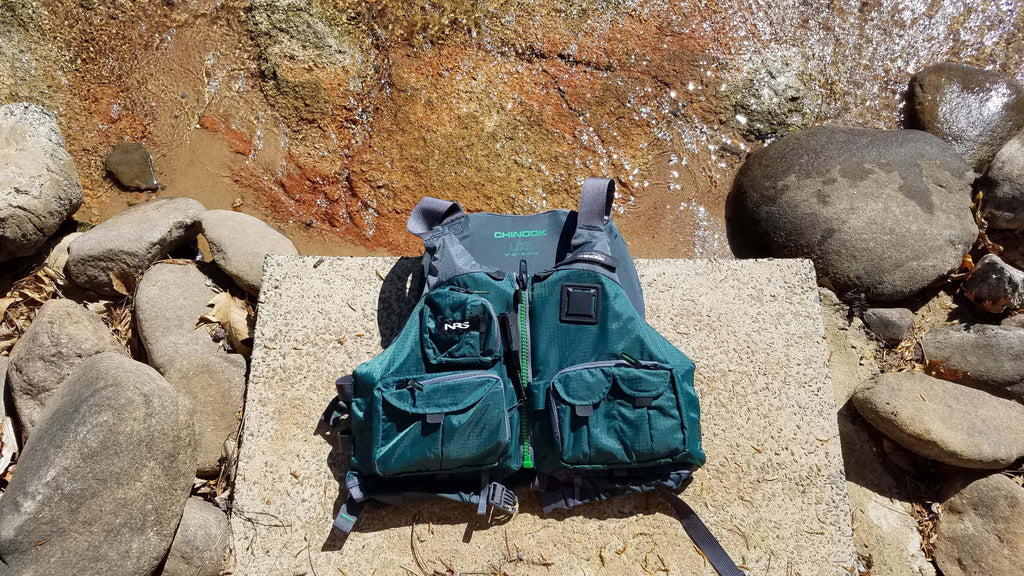
NRS Chinook
With all the organization and attachment points needed for your fishing accessories, the NRS Chinook Fishing PFD is a go-to Type III life jacket for kayak anglers.
Check out the NRS Chinook Fishing PFD on the Festive Water Store.
Recreation & Touring
From low profile to high float, front zip to side entry, there are a variety of PFD styles to fit a range of body types and boating needs.Recreational kayakers need a comfortable PFD that doesn't get in the way of paddling. Enter the NRS Ninja low profile PFD.
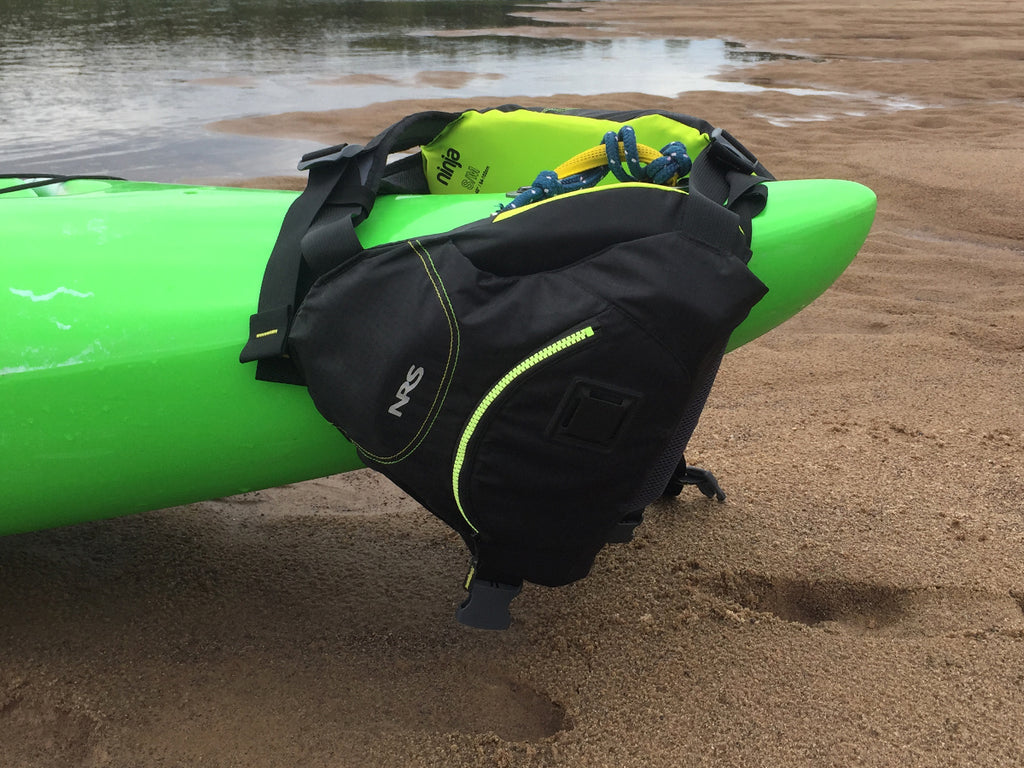
NRS Ninja
For recreational and touring kayakers, it’s hard to beat the NRS Ninja Low Profile PFD. While it's very popular in the whitewater community, those same features make it a great recreational PFD too. With the most open shoulder area and lowest core padding of any vest we tested, the NRS Ninja is an obvious choice for paddlers searching for a low-profile vest. The soft interior fabric feels comfortable on bare skin, keeping you nice and cool no matter how hard you paddle.
Check out the NRS Ninja on the Festive Water Store.
SUP
Most SUP paddlers prefer minimalist PFDs that offer maximum freedom of movement. Many prefer belt-style inflatable vests that need not be inflated unless the paddler is somehow separated from the paddleboard.
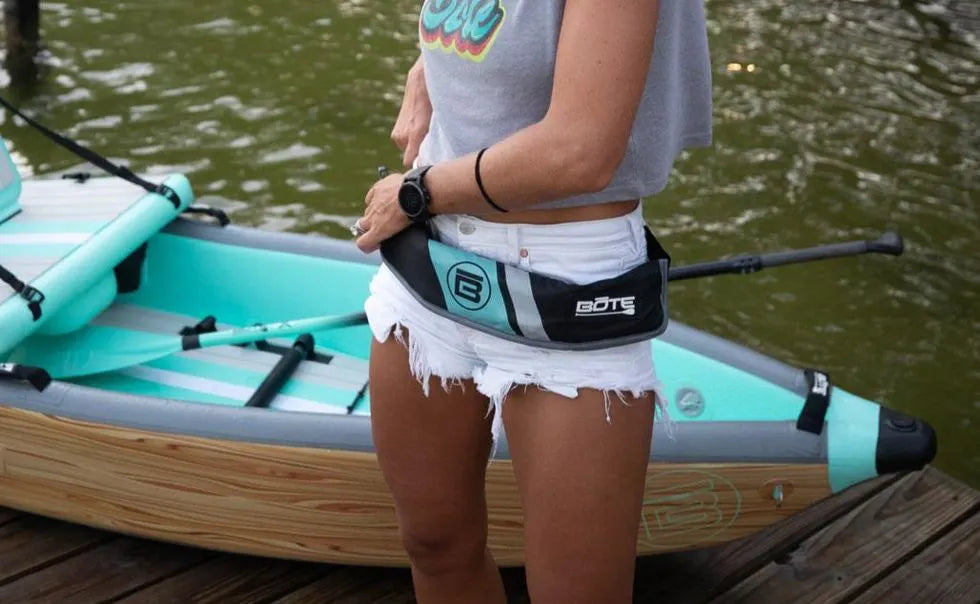
BOTE Inflatable Belt PFD
The BOTE Inflatable Belt PFD is a unique design that keeps stand-up paddleboarders (SUP), anglers, boaters, and other paddlers safe without compromising movement! It has a universal fit, and stays out of the way. A quick pull of the deployment cable inflates the PFD. It is a Type V Non-Convertible with Type III performance (Must be worn to be legal).
Check out the BOTE Inflatable Belt PFD on the Festive Water Store.
Conclusion
Now that you’ve got a comfortable life jacket, always wear it on the water. It can save your life! We hope our recommendations are helpful. If you have any questions, or would prefer to try on some PFD’s, stop by the Festive Water shop! We’d be glad to help you with any questions about PFD’s and paddle sports!

